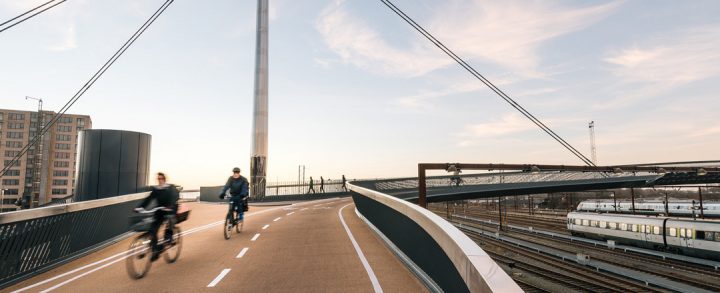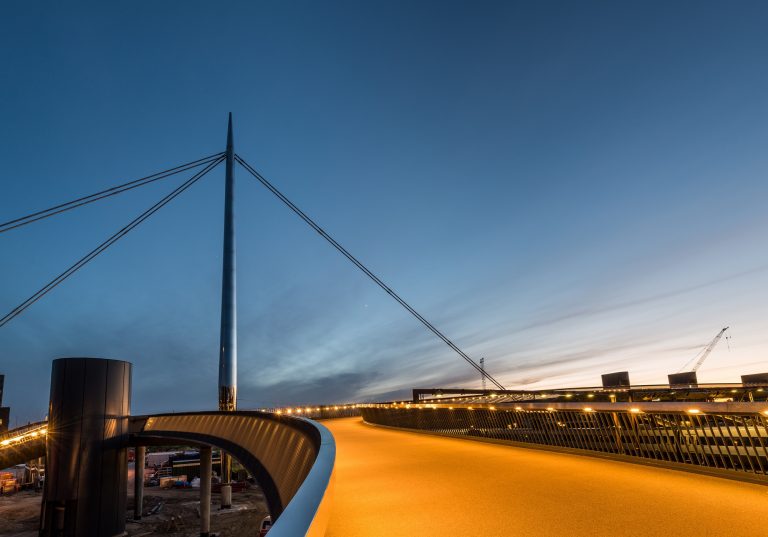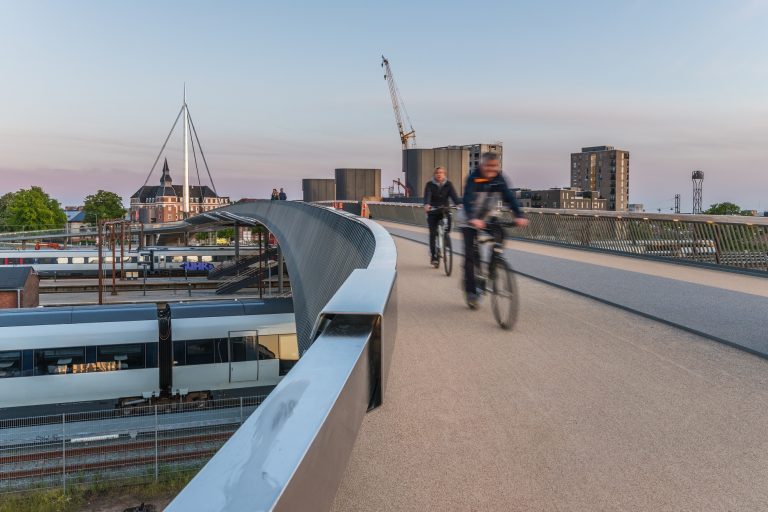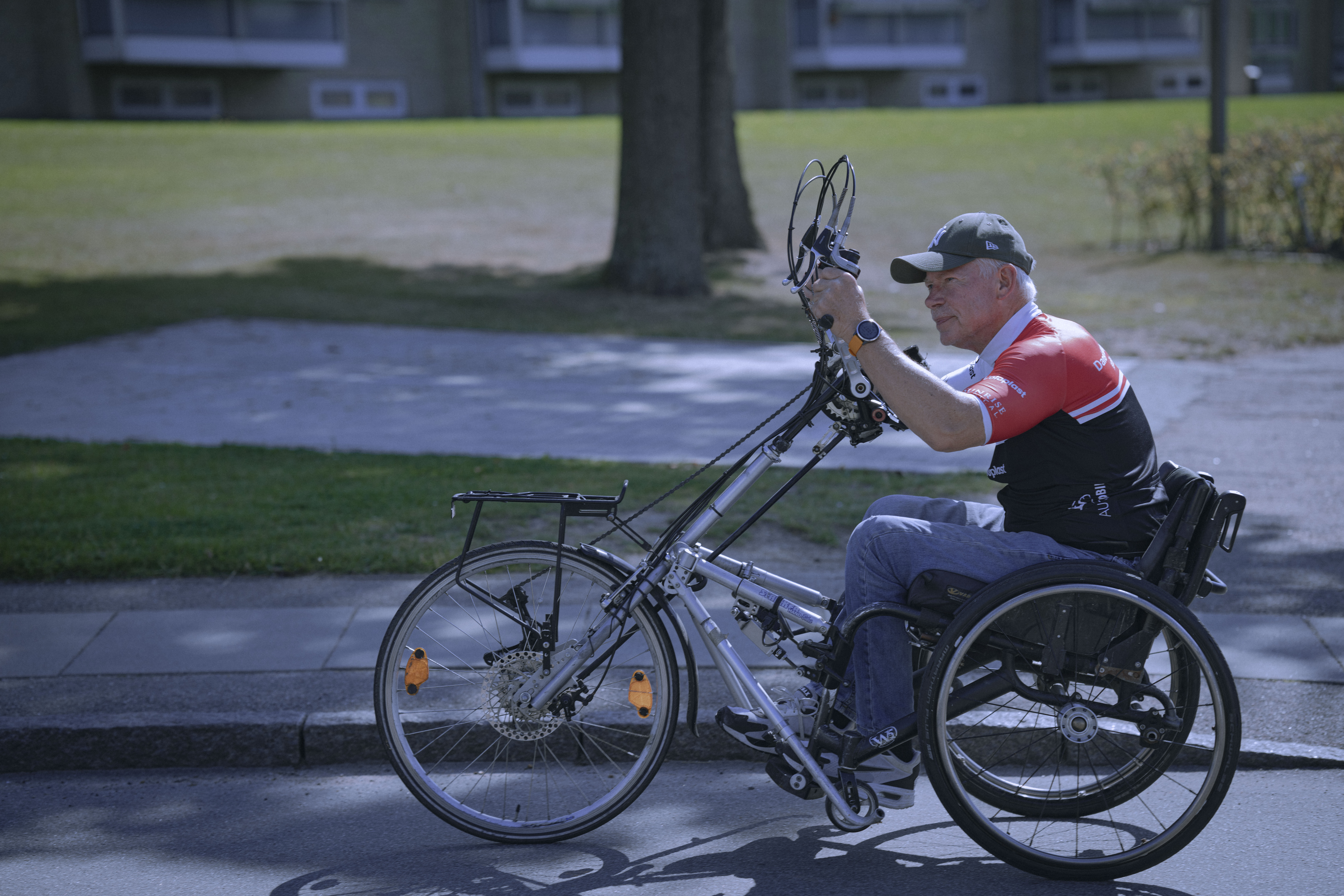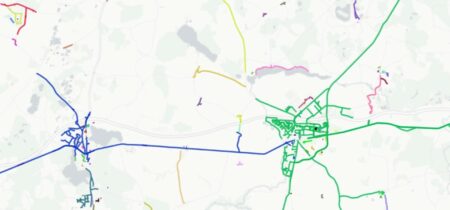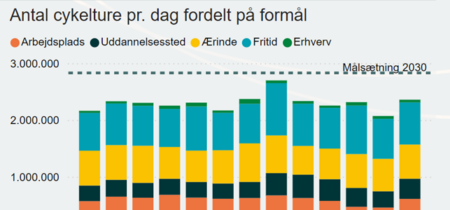Funding bicycle traffic in Denmark
Cycling projects in Denmark are primarily funded by the local authorities. However, co-financing is also an option, for example through the State bike pool, private foundations, and EU funds for establishing infrastructure and other projects.
By Aros Communications
Cycle tracks in Denmark and other projects that create better cycling conditions are primarily funded by the local authorities. The local council defrays the cost of and is responsible for establishing cycle tracks in local areas, and operations and maintenance are also a municipal task and expenditure. The small proportion of cycle tracks on state roads is funded by the state. In private areas such as universities, hospitals or large business enterprises, the cost of cycle tracks and other facilities is defrayed by the property owner or the proprietor himself.
Although the local authority is responsible for establishing cycle tracks on local roads, this does not necessarily mean they are given top priority. Internal prioritization within the local council determines the amount of money allocated to bicycle tracks. Cycle tracks are high-cost to install, but on the other hand in most cases they are an excellent and durable investment.
Cycle tracks will often be given priority when there is a special need, for example when it comes to traffic safety around schools or in residential areas with many vulnerable road users. But projects to promote cycling may also be given priority because cycling is beneficial to health and reduces local congestion, or because new cycle routes provide better options for recreational activities and increased tourism. It’s often helpful to cover the investment costs using different municipal accounts.
The majority of cycling projects are funded by the local authorities. However, for a number of years the Danish state has allocated pooled funds to support local projects that promote cycling. In individual cases private foundations have also contributed to co-financing of cyclist and pedestrian bridges, particularly in Copenhagen.
Since the local council usually foots the bill alone, or most of it, cycling must be factored in from the very beginning when the town starts planning major, new construction projects. For example, when establishing a new school, the total budget should include cycle tracks, bicycle bridges or tunnels over major thoroughfares, and last but not least, bicycle parking facilities. Experience shows that it is difficult to find funding subsequently.
Source: Troels Andersen, programme manager, City of Cyclists, Odense Municipality
- The City bridge (Byens bro) in Odense, Denmark. Photo: Odense Kommune
- The City bridge (Byens bro) in Odense, Denmark. Photo: Odense Kommune
The Bike Pool 2009-2014
The State bike pool was established in 2009 as a result of a political agreement concerning a new green profile for traffic planning. The fund was worth DKK 1 billion, and was in operation in the period from 2009-2014.
The aim of the bike pool was to promote cycling and improve cycling conditions nation- wide. The Bike Pool funds were used partly to improve cycling conditions on state owned roads and partly to subsidize cycling projects initiated by local authorities, organizations and businesses that were eligible to apply for co-financing for projects to promote cycling.
During the five years of its existence the fund subsidized a number of different projects and activities, primarily cycle tracks and bicycle parking facilities, but also projects whose aim was to create new knowledge or put a greater focus on cycling by means of development or campaign activities.
The pool was primarily intended for the local authorities, but businesses and organizations were also eligible to apply for cycle project funding.
Experience and results of the bike pool
The Road Directorate has drawn up a number of progress reports in an on-going assessment of the results of all projects subsidized by the bike fund. The final assessment will not be completed until sometime in 2019.
However, it is already clear that the bike pool has resulted in a number of projects and initiatives each of which has contributed in its own way to the improvement of cycling conditions, and raised public awareness of cycling, thereby making it more attractive to choose the bicycle as a transport means to work and leisure. Many of these activities would never have seen the light of day if the subsidies had not been available.
It has not been possible to quantify the total increase in bicycle traffic as a result of the bike pool. However, the results show an average increase in bicycle traffic of approx. 24% on the new cycle track stretches subsidized by the bike pool. This is in accordance with the typical impact of new cycle tracks in Danish cities. The results show that there are road users who have switched from cars and public transport to the bicycle, and that new types of cycle trips have come into being.
Long term strategies reinforce initiatives
Two thirds of the beneficiaries responded that they had increased their own cycling investments following the subsidy. On the whole the bike pool has meant that cycling is now on the agenda of many towns, businesses and organizations nation- wide.
Experience with the bike pool also shows that initiatives in the entire field of cycling are reinforced when the activity is based on a robust, long- term strategy and vision as well as the option of co-financing. This means that the local authorities and other players are able to work within a concrete and predictable framework, and the aim of the total project is clearer.
Generally speaking, the assessment shows that the bike pool served its purpose, but there continues to be a great need for better infrastructure, new knowledge, and campaigns and innovation in the entire field of Danish cycling since bicycle traffic is on the decline in large parts of the country in spite of the initiatives of recent years.
Bike pool facts, 2009-2014
- A total of 338 projects received subsidies, which is the equivalent of approximately one third of the 1013 applications that were sent.
- The baseline subsidy percentage was 40%, but in the case of especially innovative projects it could be increased to 100%.
- The bike pool distributed a total of DKK 717 million in subsidies. This means that together with the local authorities’ own funding the pool resulted in cycling investments of more than DKK 2 million.
Other pools that subsidize cycling projects
There is an ongoing political will in Denmark to support municipal cycling projects in particular. In addition to the Bike pool 2009-2014 special pools have been earmarked for the cycle superhighways, bicycle parking facilities, and signage of the national cycle routes. The largest grant, which targeted cycle superhighways and bicycle parking facilities, was DKK 344 million.
In 2017 The Pool for More Bicycle Traffic (Puljen til mere cyklisme) disbursed approx. DKK 90 million, which had been earmarked in connection with a far reaching political agreement on bicycle traffic, to 36 cycling projects all over the country. In 2018 the same agreeing parties earmarked a further DKK 106 million for nation- wide cycling projects.
Sources: Zofia Jagielska, engineer, Traffic safety and cycling, Danish Road Directorate + Vejdirektoratet.dk, , the Bicycle Pool 2014, report 533, status and selected examples, the Bike Pool 2009-2014. Midway assessment, 554-2016
Foundation support for cycling projects
Another option in Denmark is applying for foundation support for cycling projects and construction.
Local authorities are not often granted foundation support for cycling projects, but the 2018 GF Foundation traffic prize awarded grants to several municipal authorities. In addition, there are a number of cases where foundations have paid for the more spectacular infrastructure projects, notably in Copenhagen, where several bicycle bridges were either entirely or partially financed by foundations.
Civil society organizations usually have a better chance of receiving grants from private foundations. Danish Cyclists’ Federation and Cycling Without Age are organizations that are beneficiaries of private foundations, including Nordea-Fonden, TrygFonden and Østifterne, in order to finance projects that increase traffic safety and strengthen cycling culture.
The foundation Cycling Without Age has received grants for new rickshaws for its work, and thanks to foundation grants, Danish Cyclists’ Federation was able to co-finance municipal bicycle playgrounds and develop and carry out national Bike to School campaigns, All Kids Bike campaigns, and the nursery school campaign We Can Bike!
Foundation work is time consuming and demanding
However, applying for foundation grants takes a great deal of time and energy. Designing project ideas, selecting potential foundations, and adjusting the application to the individual foundation’s charter, articles of association and granting requirements is a highly demanding process. Another time consuming task is finding out what else the foundations supports, how the foundation expresses itself in public, and what themes are on its agenda.
Foundations generally have many resources at their disposal, and they’re certainly worth looking into when financing cycling projects. On the other hand, they may also be a vulnerable type of funding as the processing procedure is often lengthy, and it can be difficult to have alternate types of funding lined up if an expected grant doesn’t materialize.
Long term planning can thus be difficult if the project funding is based on foundation grants. This is why it’s always worth considering a cooperation agreement for projects of several years’ duration. Danish Cyclists’ Federation, among others, has been currently experiencing an increasing demand on the part of Danish foundations for cooperation between multiple organizations and municipalities in order to give the project a broader base and a greater likelihood of continuing after the project’s completion.
EU funds that support cycling projects
Since Denmark is a member of the EU, Danish players are eligible to apply for EU funds for different types of cycling projects and construction. Several larger Danish municipalities have been involved in EU funded cycling projects. Although this makes it possible to test new initiatives and concepts, the general feeling is that one should not go into it for the money because there is a great deal of administrative work involved.
Applicants should be aware that there is a difference between direct and indirect support. Applications for indirect support go through the Danish Business Authority, while applications for direct support are sent directly to the relevant EU programme, for example Horizon 2020.
Indirect support from structural funds
One option is to apply for EU support from the structural fund that supports the member states’ regional development programmes. The Danish Business Authority selects projects and decides what should be supported in Denmark.
Generally speaking it’s easier to apply for indirect funding than for direct funding, since the projects are selected by the member state and the application framework and requirements are not necessarily as rigid. The Danish Business Authority supports small and medium-sized enterprises, for example.
Interreg Europe is an interregional cooperation programme. It includes the EU member states as well as Norway and Switzerland, and offers co-financing to regional and national institutions such as public authorities, regional development agencies, educational institutions, etc. Its aim is to establish networks and exchange experience across countries and regions, and thereby create good regional practice on the European level. Interreg Europe allocates indirect funding.
Interreg Europe helps regional and local governments across Europe to develop and deliver better policy, and supports public authorities, managing authorities, research institutes, and non-profit organizations.
Financial support from Interreg Europe must fall into one of the following four categories:
- Research, technology development and innovation
- SME competitiveness
- Low carbon economy
- Environment and resource efficiency
Read more about financing options: https://www.interregeurope.eu/about-us/what-is-interreg-europe/
Direct support
The biggest programme is Horizon 2020 with nearly EUR 80 million of funding available over 7 years (2014-2020) in addition to the private and government investment that the money will attract. Horizon 2020 supports research and innovation in a large number of sub- programmes, and the Directorate –General for research and innovation makes funding available. Applications for direct funding are based Horizon 2020’s annual calls for proposals for specific areas of research.
See calls for proposals here: https:// ec.europa.eu/info/funding-tenders/opportunities/portal/screen/programmes/h2020
Many calls require a team of partner organizations, for example from two other member states. Horizon 2020’s mission is to promote cooperation between EU member states. Horizon 2020 is open to everyone, – innovative business enterprises, researchers, universities, research institutes, public institutions, associations, NGOs, etc. The programme supports innovative projects that promote research.
Horizon 2020 will continue to operate as Horizon Europe after the year 2020.
All projects that have received direct EU funding and their results can be found on https://cordis.europa.eu as well as ideas that may be applied in your domain. There is also relevant contact information. A search tip: Use search words that may be relevant to your project. For example “transport”.
Sources: Europe Direct, working for the European Commission’s Directorate-General for Communication
https://innovayt.eu/dk/horizon-2020/
http://www.interregeurope.eu/discover-projects/
https://ec.europa.eu/regional_policy/da/policy/what/glossary/i/interreg-europe
https://www.interregeurope.eu/about-us/what-is-interreg-europe/


